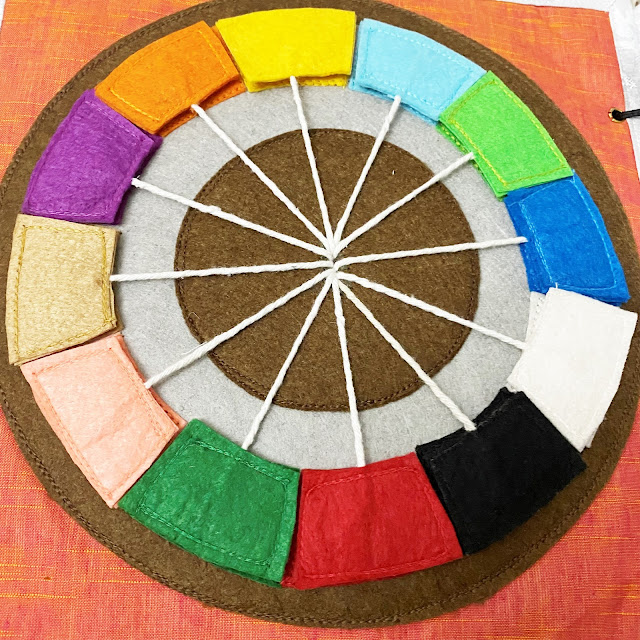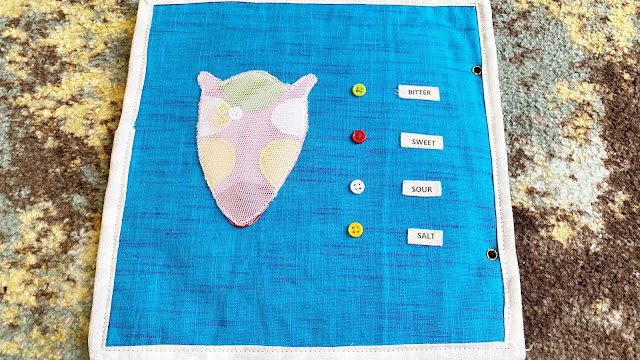Deepika Suresh Ranjith lives in Atlanta in the USA. She runs Creative PuppetZ that makes creative quiet books and cloth toys. Let us hear from Deepika about these products and how they are good for early child development, how electronic toys can be harmful, and also about how small businesses compete with big giants.
 |
| Deepika Suresh Ranjith - Founder of Creative PuppetZ |
How did you get to know about quiet books and cloth toys? Can you tell us more about them?
My daughter’s first cloth toy was gifted by the
hospital where she was born. It was a monochrome cloth book. Later, I
saw a video online on doll house quiet books. I was very fascinated by the
amount of creativity built-in to create these books. Then, I started reading more about cloth toys
and understood its benefits for kids in their early development.
So, I wanted to recreate similar books. That’s how the
first cloth book for Creative PuppetZ was made. I made the first page/book when
my daughter was around eight months old. As a polymer clay crafter in the past,
exploring different craft mediums was much easier, and crafting helped as therapy
during my early parenting months.
When did you
start Creative PuppetZ?
I started to create activities in early 2017. Creative
PuppetZ started to operate with the help of staff by the end of 2018. As I got
help for stitching the books, I focused more on designing the books. This helped
to improve both the quality and quantity of the books.
What is the difference between a quiet book and a cloth
toy?
Quiet books have interactive activities like buttoning and zipping. The children can explore the quiet or busy books without any conversations with the parent. A quiet book may have a single page or a group of pages bound together as a book with eyelets.
 |
| Quiet Book - Weave Button Tie |
On the other hand, cloth toys can be in any form. Anything printed on top of the cloth is known as a cloth toy. Cube and mat can also be called cloth toys. The kids can roll the cloth toy and touch and feel it.
 |
| Cloth Toy - Festive Sensory Mat |
What are the different materials used to make a quiet
book?
Quiet books are mainly made from different texture fabrics
like cotton, felt, fur, etc. They are mostly made with sustainable materials
which are in turn stitched together. Other raw materials like Velcro, wooden
buttons, metal clips, buckles are used in different activities based on the
need.
What are the advantages of quiet books over ordinary
books?
All the cloth pieces/books help kids to touch, feel, explore,
and connect with the animal/ flower/shapes/objects and so on. This aids
positive development, mainly sensory skills and fine motor skills (brushing
teeth and opening a box) in babies, kids, and adults.
As they are made of cloth, their longevity is more when
compared to paper/ cardstock/board books. Cloth books can be gently wiped with a
wet cloth and pat dried in sunlight.
Most of the cloth books do not operate with batteries.
So, they don’t emit bright light or produce inappropriate noises which are
harmful to the early development of babies and kids. We should keep in mind
that, only if early development is good, the children grow up to be responsible
adults.
Video of Sensory Festive Cube:
Why are you focusing on selling as individual pages
than whole books?
Completing all the activities in a book (maybe four or
five pages) together will be overwhelming for kids. But, if they are given a
single page, it creates a sense of happiness in their minds that they have
achieved or completed something.
Also, the main motto of Creative PuppetZ is making
things affordable for parents to purchase so that every kid can explore cloth
toys based on their age. Every cloth activity is hand cut and machine
stitched. Though we make our products
with our staff, making of cloth activities comes up with its own price tag as
creating these activities with great quality is time-consuming. Hence, we sell
as individual activities as it’s a win-win situation for parents/caregivers and
kids.
But, in case parents/ adults need a custom order, we
provide them options to choose activities and then make it as a book. Even
though it’s a whole book, we provide eyelets so kids can comfortably play with
one activity without getting overwhelmed.
How do you get ideas for activities in your quiet books?
For example, the belt fixing activity was so good. How did you get the idea or
go about it?
Creative PuppetZ activities are inspired 60% to 75% from
the toys which my daughter plays, the children’s books we read, cloth toys/books
which are found on Pinterest, and other social media platforms. We try to add more features to the cloth toy
which already exists in the market. Sometimes, it leads to success, and
sometimes it may fail too. So, designing is more about learning from our
mistakes.
Video of Life Skills Belt Fixing Activity for Fine Motor Skills.
What is the target age group of children for your
products? Is there any size or weight specifications for the books?
We are designing cloth books/toys for babies from two
weeks to children up to 8 years or until they are interested to play. All our
cloth books for babies and toddlers will be mostly 15 * 15 cm so that kids can
easily grab them and play. Cloth books
for preschoolers are 25 * 25 cm in size. The weight is designed so that kids
can handle the toys easily.
 |
| Color Palette |
How do you convince people to go for quiet books?
Team Creative PuppetZ has taken on the responsibility
of educating parents about the need for cloth toys for child development. Quiet
books are not new. They were made in small
quantities by local artisans across the globe for many decades.
Owing to the boom of social media and its connectivity
and being an engineer myself, I understood the benefits of cloth books and I
started my own brand. So, we use the same social media to create videos and
content that show the benefits of cloth toys to adults/parents. We also receive
orders through social media.
We show customers that our cloth books have life-skill
activities, custom-made educational concepts, day-to-day tasks, with at least
one fine motor skill included. We
also share how these cloth toys help to keep children screen-free, occupy less
space, and are travel-friendly. The
importance of cloth books is being understood slowly by parents/adults.
Video of Monochrome Cloth Book.
Do you mean to say that all electronic toys are bad? What are the other toys you prefer?
With the new normal and virtual schools/classes,
children are very dependent on electronic devices such as laptops, mobiles,
iPads, and tablets. The screen time has increased a lot. If the toys also have
the same technology, it harms the child’s early development. Not every
electronic toy is tested for noise levels or light intensity levels.
Most of the electronic toys use the press buttons like
the ones in a TV remote control. So, learning from the toy is hard, until it’s
really created for educational purposes.
Age-old toys/activities which were in vogue decades
back have been slowly noticed by parents/adults. Wooden toys (blocks in
different forms, pegboards & so on), Crochet toys, puzzles in different
forms/types (wooden, cardboard, popsicle, cloth, etc.,), play dough, board games,
and of course, cloth books are some of the toys which have been welcomed by
parents/adults slowly. Most of these toys don’t need big machinery to make
them. So, small businesses work hard in creating them and they design toys that
help positive development in kids.
Will kids be
happy to switch all of a sudden from electronic toys to educational/fine motor
toys?
No. Change won’t happen in a day. The process is
gradual. Kids when switching from electronic toys to wooden toys, cloth books,
etc. won’t play with these toys for days. These toys won’t emit sound or light
to attract kids. So, parents can keep these toys close to the kids and allow
them to slowly explore.
 |
| Deepika's Daughter Playing with Fine Motor Activity |
With the availability of small businesses/online pages/online shopping, is it overwhelming and confusing for parents/adults? Is everyone really interested in purchasing from small businesses or is it easier to purchase from e-commerce websites?
Yes, I would say it’s not only for the toy market, but
the availability of information online is always abundant. So, it’s better if adults/parents
do a lot of research with the information present in their hands. Going through
the Website/Facebook/Instagram pages of a small business and reading their
reviews can help to find out who is genuine.
Most of these small businesses choose to have their
own website as it’s the only way they can get good revenue. Small businesses
can’t manufacture toys in large quantities as it requires huge manpower.
Most of these small businesses work with low-profit margins.
So, they price their products in such a way that covers all the expenses to run
their brand and also charge separately for shipping costs.
So, most parents find that the price tag of small
businesses is higher than those of big e-commerce websites. So, parents must
make a wise choice and decide if they want the quality of small business
products or the low pricing of big giants.
 |
| Taste Buds - Activity |
Can you tell us something about Journals of Momma?
Apart from crafting, I enjoy writing. JournalsofMomma
is my blog page where I write about the journey of raising my daughter. I share
reviews about children’s books which we read, toys which we explore, and so on.
As a fellow small business owner, I tend to share more about small businesses from
whom I have purchased/collaborated personally, especially the ones run by
women.
I am the author/photographer/contributor behind my
blog – JournalsofMomma. Through the blogging space, I connect with women who
have walked across different paths of life and post their guest posts in my
blog.
 |
| Deepika's Daughter Exploring Clock Page |
Below are the social media and Blog links:
Link to Creative PuppetZ Instagram: https://instagram.com/creative_puppetz
YouTube Channel of Creative PuppetZ:
https://youtube.com/channel/UCJA8i1fwiO5A9oK3NjTsA6g
Link to JournalsOfMomma Instagram: https://instagram.com/journalsofmomma
Blog: https://journalsofmomma.com
Email: journalsofmomma@gmail.com
No comments:
Post a Comment